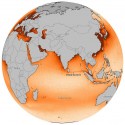Ships are the most energy efficient means of moving good across the surface of the earth. Goods moved by ship have the lowest carbon foot-print of goods moved by any other means. At the same time, modern ships are significant polluters. How can ships be so green and yet also so dirty. The answer is the fuel burned on most ocean-going ships. It goes by various names – residual oil, bunker C, No. 6 oil. Whatever you call it, it is dirty; high in sulfur, nitrogen dioxide and particulates. The exhaust gases from ocean going ships has become so bad that it can be observed from space by satellite. Thanks to Mai Armstrong of the Working Harbor Committee for pointing out the news.
A Satellite’s View of Ship Pollution
Data from the Dutch and Finnish-built Ozone Monitoring Instrument (OMI) on NASA’s Aura satellite show long tracks of elevated nitrogen dioxide (NO2) levels along certain shipping routes. NO2, is among a group of highly-reactive oxides of nitrogen, known as NOx, that can lead to the production of fine particles and ozone that damage the human cardiovascular and respiratory systems. Combustion engines, such as those that propel ships and motor vehicles, are a major source of NO2 pollution.


Yes, read the same article last month or so, but now they are saying that the fossil fuels are killing the coral.
Particles from fossil fuels ‘affect the growth of corals’
BBC News - 13 hours ago
http://www.bbc.co.uk/news/science-environment-22044229
The nitrogen oxides and oxides of sulphur are the main components of the air pollution been done by merchant ships.
To tackle this ,International maritime organisation has introduced strict regulations for marine bunkers and in the design of the engines of these ships.IMO is also very active for all type of pollution from the ships and it can be said that we are moving towards cleaner sea transport every day but what it counts today is the damage already done to our environment. We are discussing hotly about the issue in the maritime community at http://www.sailors-club.net.